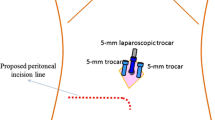Abstract
Background
The aim of this study was to evaluate day case laparoscopic herniorraphy (LH) and to ascertain the impact of trainee surgeons on its performance.
Methods
We performed a prospective study of ambulatory laparoscopic transabdominal preperitoneal herniorraphies performed in a dedicated day surgical unit between March 1996 and October 2003.
Results
A total of 840 herniorraphies were performed in 706 consecutive patients. Surgery was performed by 15 higher surgical trainees and three consultant surgeons. The mean operating times for trainees were longer for unilateral (48.4 ± 0.98 vs 41.4 ± 0.87 min, p < 0.05) and bilateral (69.0 ± 3.24 vs 53.0 ± 1.68 min, p < 0.05) repairs than for consultants. Subgroup analysis demonstrated that after an experience of 40 procedures, trainee times approached those of the consultants (41.39 ± 1.17 vs 41.4 ± 0.87 min, p= 0.31). LH repair was well tolerated and associated with minimal postoperative pain and nausea. Mean pain scores postoperatively and at 24 h were 2.69 ± 0.11 and 2.07 ± 0.09, respectively. Mean nausea scores postoperatively and at 24 h were 0.34 ± 0.06 and 0.22 ± 0.06, respectively. Ninety-three percent of patients (n = 657) were discharged within 8 h. There were two conversions to an open procedure (0.1%) and two significant complications (0.1%). Ninety-five percent of patients who responded to our questionnaire (n = 398/419) were satisfied with surgery and would undergo day case laparoscopic herniorraphy again.
Conclusions
Laparoscopic herniorraphy is a safe technique suitable for day case surgery. Operator experience dictates duration of surgery. Trainees’ operating times approach those of consultants after 40 procedures. Prolonged operating times and increased cost are not justifiable reasons for not recommending LH.






Similar content being viewed by others
References
Anonymous (2003) Laparoscopic techniques versus open techniques for inguinal hernia repair. Cochrane Database Syst Rev 1
Bloor K, Fremantle N, et al. (2003) Impact of NICE guidelines on laparoscopic surgery for inguinal hernia. Br Med J 326: 578
Brooks DC, Rattner DW, et al. (1994) A prospective comparison of transabdominal preperitoneal laparoscopic hernia repair versus traditional open hernia repair in a university setting. Surg Laparosc Endosc 4: 247–253
Choudary RK, Hasan AMF (2003) NICE guidelines on laparoscopic surgery for inguinal hernia: guidelines are less clinical excellence than hindrance. Br Med J 326: 1144
Edward CC, Bailey RW (2000) Laparoscopic hernia repair: the learning curve. Surg Laparosc Endosc Percut Tech 10: 149–153
Evans DS (2002) Laparoscopic transabdominal pre-peritoneal (TAPP) repair of groin hernia: one surgeon’s experience of a developing technique: Hunterian lecture. Ann R Coll Surg 84: 393–398
Feliu-Pala X, Martin-Gomez M, et al. (2001) The impact of the surgeon’s experience on the results of laparoscopic hernia repair. Surg Endosc 15: 1467–1470
Heikkinen TJ, Haukipuro K, Hulkko A (1998) A cost and outcome comparison between laparoscopic and Lichtenstein hernia operations in a day case unit. A randomized prospective study. Surg Endosc 12: 1199–1203
Johansson B, Hallerback B, et al. (1999) Laparoscopic mesh versus open preperitoneal mesh versus conventional technique for inguinal hernia repair: a randomized multicentre trial (SCUR Hernia Repair Study). Ann Surg 230: 225–231
Juul P, Christensen K (1999) Randomized clinical trial of laparoscopic versus open inguinal hernia repair. Br J Surg 86: 316–319
Kald A, Anderberg B (1997) Surgical outcome and cost-minimization analyses of laparoscopic and open hernia repair: a randomized prospective trial with one year follow up. Eur J Surg 163: 505–510
Kozol R, Lange PM, et al. (1997) A prospective randomized study of open vs laparoscopic inguinal hernia repair. An assessment of postoperative pain. Arch Surg 132: 292–295
Lawrence K, McWhinnie D, et al. (1996) An economic evaluation of laparoscopic versus open inguinal hernia repair. J Public Health Med 18: 41–48
Liem MSL, Van DGY, et al. (1997) A randomized comparison of physical performance following laparoscopic and open inguinal hernia repair. Br J Surg 84: 64–67
McCloud JM, Evans DS (2003) Day case laparoscopic hernia repair in a single unit. Surg Endosc 17: 491–493
Medical Research Council Laparoscopic Groin Hernia Trial Group (1999) Laparoscopic versus open repair of groin hernia: a randomized comparison. Lancet 354: 185–190
Motson R (2002) Why does NICE not recommend laparoscopic herniorraphy? Br Med J 324: 1092–1094
National Institute for Clinical Excellence (2001) Guidance on the use of laparoscopic surgery for inguinal hernia. Technology Appraisal Guidance No. 18.
National Institute for Clinical Excellence (2004) Appraisal consultation document: laparoscopic surgery for inguinal hernia. http://www.nice.org.uk
Quilici PJ, Greaney EM, Anderson S (2000) Laparoscopic inguinal hernia repair; optimal technical variations and results in 1700 cases. Am Surg 66: 848–852
Ramshaw B, Shuler FW, Jones HB (2001) Laparoscopic inguinal hernia repair: lessons learned after 1224 consecutive cases. Surg Endosc 15: 50–54
Stoker DL, Speilgelhalter DJ, et al. (1994) Laparoscopic versus open inguinal hernia repair: randomized prospective trial. Lancet 343: 1243–1245
Wellwood J, Sculpher MJ, et al. (1998) Randomized controlled trial of laparoscopic versus open mesh repair for inguinal hernia; outcome and cost. Br Med J 317: 103–110
Author information
Authors and Affiliations
Corresponding author
Rights and permissions
About this article
Cite this article
Lim, M., O’Boyle, C.J., Royston, C.M.S. et al. Day case laparoscopic herniorraphy. Surg Endosc 20, 1453–1459 (2006). https://doi.org/10.1007/s00464-004-2265-5
Received:
Accepted:
Published:
Issue Date:
DOI: https://doi.org/10.1007/s00464-004-2265-5




